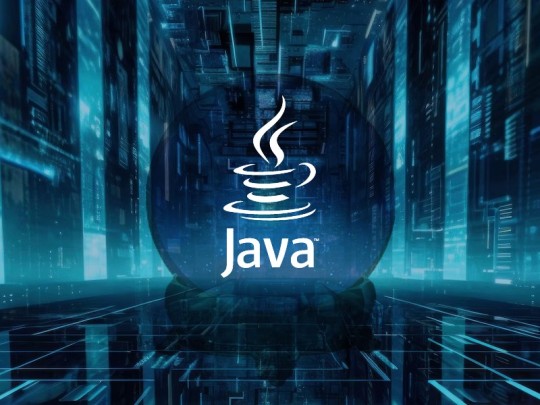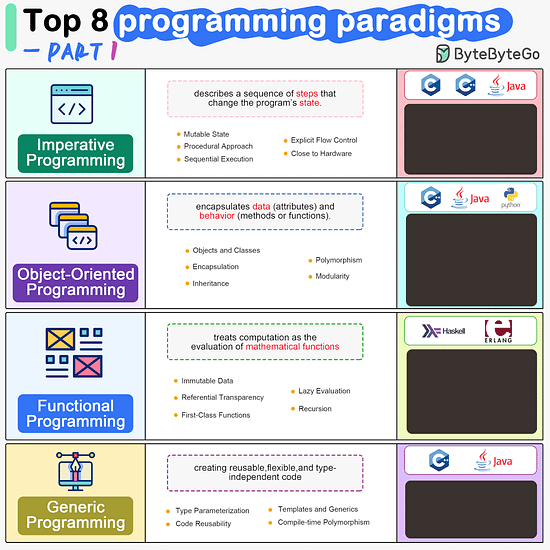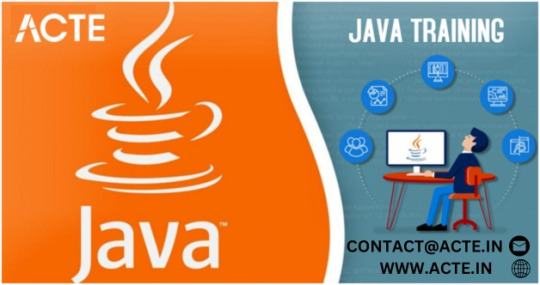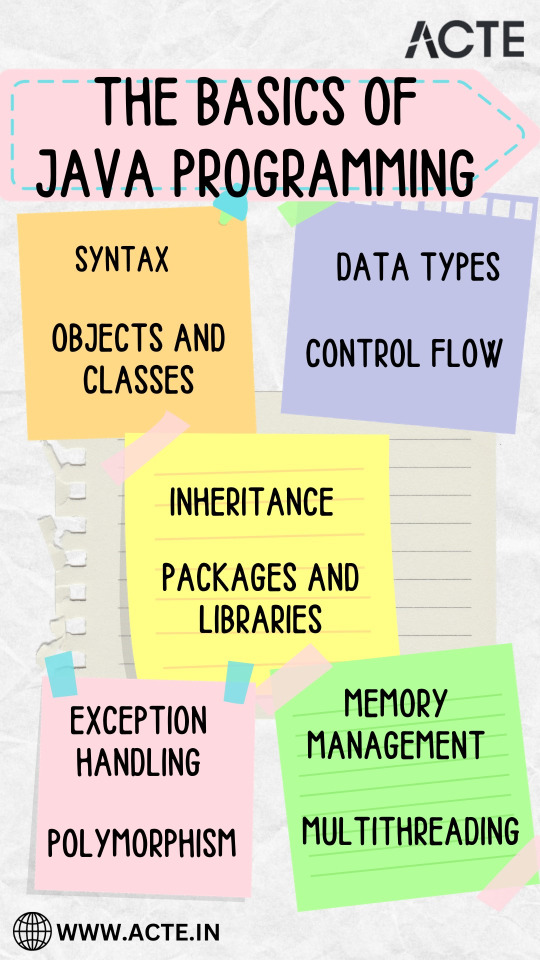#oops concepts in java
Explore tagged Tumblr posts
Text
Understanding Object-Oriented Programming and OOPs Concepts in Java
Object-oriented programming (OOP) is a paradigm that has revolutionized software development by organizing code around the concept of objects. Java, a widely used programming language, embraces the principles of OOP to provide a robust and flexible platform for developing scalable and maintainable applications. In this article, we will delve into the fundamental concepts of Object-Oriented Programming and explore how they are implemented in Java.

Object-Oriented Programming:
At its core, Object-Oriented Programming is centered on the idea of encapsulating data and behavior into objects. An object is a self-contained unit that represents a real-world entity, combining data and the operations that can be performed on that data. This approach enhances code modularity, and reusability, and makes it easier to understand and maintain.
Four Pillars of Object-Oriented Programming:
Encapsulation: Encapsulation involves bundling data (attributes) and methods (functions) that operate on the data within a single unit, i.e., an object. This encapsulation shields the internal implementation details from the outside world, promoting information hiding and reducing complexity.
Abstraction: Abstraction is the process of simplifying complex systems by modeling classes based on essential properties. In Java, abstraction is achieved through abstract classes and interfaces. Abstract classes define common characteristics for a group of related classes, while interfaces declare a set of methods that must be implemented by the classes that implement the interface.
Inheritance: Inheritance is a mechanism that allows a new class (subclass or derived class) to inherit properties and behaviors of an existing class (superclass or base class). This promotes code reuse and establishes a hierarchy, facilitating the creation of specialized classes while maintaining a common base.
Polymorphism: Polymorphism allows objects of different types to be treated as objects of a common type. This is achieved through method overloading and method overriding. Method overloading involves defining multiple methods with the same name but different parameters within a class, while method overriding allows a subclass to provide a specific implementation of a method that is already defined in its superclass.
Java Implementation of OOP Concepts:
Classes and Objects: In Java, a class is a blueprint for creating objects. It defines the attributes and methods that the objects of the class will have. Objects are instances of classes, and each object has its own set of attributes and methods. Classes in Java encapsulate data and behavior, fostering the principles of encapsulation and abstraction.
Abstraction in Java: Abstraction in Java is achieved through abstract classes and interfaces. Abstract classes can have abstract methods (methods without a body) that must be implemented by their subclasses. Interfaces declare a set of methods that must be implemented by any class that implements the interface, promoting a higher level of abstraction.
Inheritance in Java: Java supports single and multiple inheritances through classes and interfaces. Subclasses in Java can inherit attributes and methods from a superclass using the extends keyword for classes and the implements keyword for interfaces. Inheritance enhances code reuse and allows the creation of specialized classes while maintaining a common base.
Polymorphism in Java: Polymorphism in Java is manifested through method overloading and overriding. Method overloading allows a class to define multiple methods with the same name but different parameters. Method overriding occurs when a subclass provides a specific implementation for a method that is already defined in its superclass. This enables the use of a common interface for different types of objects.
Final Thoughts:
Object-oriented programming and its concepts form the foundation of modern software development. Java, with its robust support for OOP, empowers developers to create scalable, modular, and maintainable applications. Understanding the principles of encapsulation, abstraction, inheritance, and polymorphism is crucial for harnessing the full potential of OOPs concepts in Java. As you continue your journey in software development, a solid grasp of these concepts will be invaluable in designing efficient and effective solutions.
#javascript#javaprogramming#java online training#oops concepts in java#object oriented programming#education#technology#study blog#software#it#object oriented ontology#java course
3 notes
·
View notes
Text
Oops Concepts - Java Programming: Unveiling the Core Principles
Java programming stands as an enduring pillar in the coding landscape, owed largely to its robust foundation in Object-Oriented Programming (OOP). In this comprehensive guide, we will embark on a journey into the intricate world of OOP within the Java context, unraveling complex concepts and providing pragmatic examples to reinforce your understanding.
1 note
·
View note
Text
also i might need to learn some rust to prepare myself for the insane task on writing a linux-like os kernel in rust + x86 assembly that will be forced upon me during the next term. which means that i have to learn both cpp and rust kind of simultaneously? hate when this happens
#i have superficial familiarity with cpp (i know basic c + i wrote algos in cpp)#and i know enough about like oop from other languages (mainly java unfortunately)#but i have no idea how the specifics of cpp work.....#oh did i say i know basic c? sorry i mean i know c pretty well actuallt#i still have no idea what the fuck is a template. is it like a generic? no idea#i have a vague understanding of a concept of a namespace
1 note
·
View note
Text
OOPS NOTES
OOPS NOTES
View On WordPress
0 notes
Text
Today I had an OOP class. I really like the teaching method being employed by the lecturer. When I got back home I decided to write the lecture notes because the lecture was available online so I didn't have to split my attention in class between writing notes and trying to understand what was being taught. I also did a quiz on it after I finished writing my notes and I had a 10/10( ꈍᴗꈍ)
I have a programming assignment to do but imma watch the YouTube course for Java before I start on it. I want to have the key concepts down before I do it. Luckily I have the whole weekend to finish the assignment.



#studyinspo#study inspiration#study with me#studygram#back to school#study notes#college#student#university#study tips#study#study aesthetic#study blog#study motivation#studyblr#studyspo
25 notes
·
View notes
Text
The concept of object oriented programming explained
Object-oriented programming is a fundamental concept present in numerous programming languages such as C++, Java, JavaScript, and more. It becomes straightforward once you truly grasp it, and that's precisely what this post aims to help you achieve. So, stop your scrolling for a second and delve into this post for a thorough and clear explanation.

Understanding the Term "Object-Oriented"
To grasp OOP, let's begin by explaining the name itself: "Object-Oriented." This term signifies that OOP revolves around entities known as "objects."
What Exactly Is an Object?
An object in OOP is any entity that possesses both state and behavior. Consider a dog as an example: it has states such as color, name, and breed, while its behaviors encompass actions like wagging the tail, barking, and eating.
The reason we introduce the concept of objects in programming is to effectively represent real-world entities, a task that cannot be accomplished with conventional variables or arrays.
Classes: Abstract Forms of Objects
Now, what about classes? A class is essentially the abstract form of an object. If we take the example of a "dog," the object "Mydog" is a concrete instance, while the class "dog" represents dogs in a more general sense. Think of a class as a blueprint or template from which you can create individual objects.
Four Pillars of Object-Oriented Programming
Now that we've established the fundamentals of objects and classes. OOP is built upon four key principles:
Inheritance: Inheritance occurs when one object inherits all the properties and behaviors of a parent object. It promotes code reusability and facilitates runtime polymorphism.
Polymorphism: Polymorphism entails performing a single task in multiple ways. For instance, it can involve presenting information differently to customers or implementing different shapes like triangles or rectangles.
Abstraction: Abstraction is about concealing internal details while exposing functionality. Consider a phone call; we don't need to understand the intricate inner workings.
Encapsulation: Encapsulation involves bundling code and data into a single unit. Just like a capsule contains various medicines . In a fully encapsulated class (e.g., a Java bean), all data members are private, ensuring data integrity and controlled access.
I remember finding these images that explained these concepts using the 'Squid Game' series, and they are just perfect. So, I'm sharing them here and giving all credit to their owner :
Polymorphism , Inheritance , Encapsulation
#code#codeblr#css#html#python#studyblr#progblr#programming#comp sci#web design#web developers#web development#website design#webdev#website#tech#html css#learn to code#OOP#object oriented programming
43 notes
·
View notes
Text

ByteByteGo | Newsletter/Blog
From the newsletter:
Imperative Programming Imperative programming describes a sequence of steps that change the program’s state. Languages like C, C++, Java, Python (to an extent), and many others support imperative programming styles.
Declarative Programming Declarative programming emphasizes expressing logic and functionalities without describing the control flow explicitly. Functional programming is a popular form of declarative programming.
Object-Oriented Programming (OOP) Object-oriented programming (OOP) revolves around the concept of objects, which encapsulate data (attributes) and behavior (methods or functions). Common object-oriented programming languages include Java, C++, Python, Ruby, and C#.
Aspect-Oriented Programming (AOP) Aspect-oriented programming (AOP) aims to modularize concerns that cut across multiple parts of a software system. AspectJ is one of the most well-known AOP frameworks that extends Java with AOP capabilities.
Functional Programming Functional Programming (FP) treats computation as the evaluation of mathematical functions and emphasizes the use of immutable data and declarative expressions. Languages like Haskell, Lisp, Erlang, and some features in languages like JavaScript, Python, and Scala support functional programming paradigms.
Reactive Programming Reactive Programming deals with asynchronous data streams and the propagation of changes. Event-driven applications, and streaming data processing applications benefit from reactive programming.
Generic Programming Generic Programming aims at creating reusable, flexible, and type-independent code by allowing algorithms and data structures to be written without specifying the types they will operate on. Generic programming is extensively used in libraries and frameworks to create data structures like lists, stacks, queues, and algorithms like sorting, searching.
Concurrent Programming Concurrent Programming deals with the execution of multiple tasks or processes simultaneously, improving performance and resource utilization. Concurrent programming is utilized in various applications, including multi-threaded servers, parallel processing, concurrent web servers, and high-performance computing.
#bytebytego#resource#programming#concurrent#generic#reactive#funtional#aspect#oriented#aop#fp#object#oop#declarative#imperative
7 notes
·
View notes
Text

Java OOPs Concept-Encapsulation
Let's see the definition of OOPs concepts of Java called Encapsulation:
#java#javalanguage#javaprogramming#programming#coding#code#trending#education#technology#tech#engineering#software#development#softwaredevelopment#computer#computertechnology#oops#javaoops#oopsconcept#online
3 notes
·
View notes
Text
Mastering Java: Your Comprehensive Guide to Programming Excellence
Embarking on the journey of mastering Java is akin to entering a realm of endless possibilities. Java, a versatile and widely-utilized programming language, offers a broad spectrum of applications, from crafting web and mobile applications to powering robust enterprise systems. Whether you are a novice in the realm of coding or a seasoned programmer looking to broaden your skill set, the path to proficiency in Java is an exciting one.

In this comprehensive guide, we will be your guiding light through the intricacies of Java, starting from the foundational basics and progressing to the more advanced aspects of the language. Our objective is to equip you with the knowledge and skills that form a robust and unshakable foundation for your journey into the vibrant world of Java. Fasten your seatbelt as we embark on this exhilarating exploration, charting a course that will empower you to thrive in the ever-evolving landscape of software development.
Here's a 8-step guide to effectively learn Java
Step 1: Setting Up Your Development Environment
Your journey to becoming a proficient Java developer commences with setting up your development environment. The essential components are the Java Development Kit (JDK) and an Integrated Development Environment (IDE) like Eclipse or IntelliJ IDEA. These tools aren't just convenient; they're the gears that will drive your Java programming endeavors. They streamline the coding process, provide useful features, and offer an organized workspace, making your coding experience efficient and enjoyable.
Step 2: The Foundation - Learning the Basics
With your development environment ready, it's time to delve into the fundamental building blocks of Java. Begin by acquainting yourself with data types, variables, operators, and control structures. These are the nuts and bolts of the language, and a solid grasp of these concepts is essential. You'll find an abundance of online tutorials and beginner-friendly Java books to assist you at this stage.
Step 3: Navigating the World of Object-Oriented Programming (OOP)
The object-oriented programming (OOP) approach is well known in Java. To harness the true power of Java, immerse yourself in the world of OOP. Understand the concepts of classes, objects, inheritance, encapsulation, and polymorphism. This knowledge forms the bedrock of Java programming and enables you to design efficient, organized, and scalable code.
Step 4: Mastering Data Structures and Algorithms
Data structures (such as arrays, lists, and sets) and algorithms are the secret sauce behind solving real-world problems efficiently. As you progress, dive into the world of data structures and algorithms. These are the tools that will empower you to handle complex tasks and optimize your code. They're your go-to assets for creating efficient and responsive applications.
Step 5: The Art of Exception Handling
Java boasts a robust exception-handling mechanism. Understanding how to handle exceptions properly is not just an add-on skill; it's a vital aspect of writing reliable code. Exception handling ensures that your code gracefully manages unexpected situations, preventing crashes and delivering a seamless user experience.
Step 6: Exploring Input and Output Operations
In this step, you'll explore the realm of input and output (I/O) operations. Mastering I/O is crucial for reading and writing files, as well as interacting with users. You'll gain the ability to build applications that can efficiently process data and communicate effectively with users.
Step 7: Conquering Multi tasking
Java's support for multi tasking is a significant advantage. Understanding how to manage threads and synchronize their actions is vital for creating concurrent applications. Multithreading is the key to developing software that can handle multiple tasks simultaneously, making your applications responsive and scalable.
Step 8: Building Projects and Real-World Practice
Theory is only as valuable as its practical application. The final step involves applying what you've learned by building small projects. These projects serve as a proving ground for your skills and provide valuable additions to your portfolio. Whether it's a simple application or a more complex project, the act of building is where the real learning takes place.

As you step into this vibrant realm of Java, remember that continuous learning is the key to staying relevant and effective in the ever-evolving field of software development. Be open to exploring diverse applications, from web development to mobile apps and enterprise solutions, and never underestimate the power of hands-on practice. Building projects, no matter how small, will solidify your knowledge and boost your confidence.
In your quest to master Java, ACTE Technologies stands as a valuable ally. Their expert guidance and comprehensive training programs will sharpen your skills, boost your confidence, and pave the way for a rewarding career in software development. Whether you're embarking on your Java journey or looking to take your skills to the next level, ACTE Technologies offers the resources and support you need to thrive in the world of Java programming.
So, with Java as your trusty companion, and ACTE Technologies as your guide, the possibilities are boundless. Your journey is just beginning, and the world of software development awaits your innovation and expertise. Best of luck on your path to mastering Java!
9 notes
·
View notes
Text
What Is Java And Its Importance ? Before that I will tell you the best institute for java course in Chandigarh ?

Java training in Chandigarh is a popular choice for students and professionals looking to enhance their programming skills and build a career in software development. Chandigarh, known for its educational institutions and IT hubs, offers a range of training programs for beginners and advanced learners. These courses are designed to provide hands-on experience in Java programming, covering core concepts like object-oriented programming, data structures, multithreading, and exception handling. Advanced topics such as Java frameworks (Spring, Hibernate), web development, and Android app development are also included in some programs.
Do you want to know about how Java works or how to get start with it ?

Java is one of the most important and widely used programming languages in the world, and its significance stems from several key features and advantages:
1. Platform Independence
Java's "write once, run anywhere" (WORA) capability allows code to run on any platform with a Java Virtual Machine (JVM). This cross-platform compatibility makes it a versatile choice for developers.
2. Object-Oriented Programming (OOP)
Java is based on OOP principles, such as encapsulation, inheritance, polymorphism, and abstraction. This makes it easier to design modular, reusable, and maintainable code.
3. Robust and Secure
Java has strong memory management, exception handling, and built-in security features, making it a reliable choice for developing secure and stable applications.
Now I will tell you the best Institute for java course in Chandigar

Excellence Technology is a renowned IT training institute located in Chandigarh, India, known for providing high-quality education and skill development in various fields of information technology. It has earned a reputation for its industry-oriented training programs, experienced faculty, and excellent placement support. Here’s an overview of what makes Excellence Technology stand out:
we provide IT courses like Java ,Full stack development , web design Graphic Designs and Digital Marketing.
Contact us for more details 9317788822

EXTECH DIGITAL is a renowned IT training institute located in Chandigarh, India, known for providing high-quality education and skill development in various fields of information technology. It has earned a reputation for its industry-oriented training programs, experienced faculty, and excellent placement support. Here’s an overview of what makes Excellence Technology stand out:
we provide IT courses like Java ,Full stack development , web design Graphic Designs and Digital Marketing.
Contact us for more details 9317788822

EXCELLENCE ACADEMY is a renowned IT training institute located in Chandigarh, India, known for providing high-quality education and skill development in various fields of information technology. It has earned a reputation for its industry-oriented training programs, experienced faculty, and excellent placement support. Here’s an overview of what makes Excellence Technology stand out:
we provide IT courses like Java ,Full stack development , web design Graphic Designs and Digital Marketing.
Contact us for more details 9317788822
About Author
Nikita Thakur
Java Ai Developer| 2+ Years of Experiences |Excellence Technology
Nikita Thakur - Java & AI Developer with 2+ Years of Experience Nikita Thakur is a skilled software developer with over 2 years of experience specializing in Java programming and Artificial Intelligence (AI). She has honed her expertise through hands-on projects, continuous learning, and professional training at Excellence Technology, a renowned IT training institute in Chandigarh. Here’s an overview of her profile:
0 notes
Text
A Hands-On Approach to the Factory Pattern: Creating Custom Objects
Introduction A Hands-On Approach to the Factory Pattern: Creating Custom Objects is a fundamental concept in object-oriented programming (OOP) that allows you to create objects without specifying the exact class of object that will be created. This tutorial will guide you through the process of implementing the factory pattern in various programming languages, including Python, Java, and…
0 notes
Text
Senior Software Engineer
experience with Dot Net or Java Solid experience in object oriented programming & with good analytical skills Experience… skills NET Core solid Oops and C# concepts. REST services and Web API development Entity framework Angular 8+/React Full… Apply Now
0 notes
Text
Senior Software Engineer
experience with Dot Net or Java Solid experience in object oriented programming & with good analytical skills Experience… skills NET Core solid Oops and C# concepts. REST services and Web API development Entity framework Angular 8+/React Full… Apply Now
0 notes
Text
What Are The Core Subjects In B.Tech Computer Science?

B.Tech in Computer Science Engineering (CSE) is one of the most popular engineering programs, focusing on computing technologies, programming, and system design. The curriculum is designed to equip students with theoretical and practical knowledge in various domains of computer science. Here are the core subjects that form the foundation of a B.Tech CSE program.
1. Programming and Data Structures
This subject introduces students to fundamental programming languages like C, C++, Java, and Python. It also covers data structures such as arrays, linked lists, stacks, queues, trees, and graphs, which are essential for efficient algorithm development.
2. Algorithms
Algorithms play a crucial role in problem-solving. Students learn about searching, sorting, dynamic programming, and graph algorithms. They also explore algorithm design techniques like divide and conquer, greedy algorithms, and backtracking.
3. Computer Networks
This subject covers networking fundamentals, including the OSI and TCP/IP models, data communication, network protocols, and security. It helps students understand how computers communicate over networks like the internet.
4. Database Management Systems (DBMS)
DBMS introduces students to relational databases, SQL, normalization, indexing, and transactions. Popular database systems like MySQL, PostgreSQL, and MongoDB are also studied in practical applications.
5. Operating Systems (OS)
Operating systems manage computer hardware and software resources. Topics include process management, memory management, file systems, scheduling algorithms, and concurrency in OS like Windows, Linux, and macOS.
6. Object-Oriented Programming (OOP)
OOP focuses on concepts like classes, objects, inheritance, polymorphism, encapsulation, and abstraction. Java, C++, and Python are commonly used languages for OOP principles.
7. Computer Architecture and Organization
This subject explores the internal structure of computers, including CPU design, memory hierarchy, instruction sets, and input/output mechanisms. It helps students understand how hardware and software interact.
8. Artificial Intelligence (AI) and Machine Learning (ML)
AI and ML are growing fields in computer science. Students learn about neural networks, deep learning, natural language processing, and AI algorithms that help in automation and decision-making.
9. Software Engineering
This subject focuses on software development methodologies, testing, maintenance, and project management. Agile and DevOps practices are commonly discussed.
10. Cybersecurity and Cryptography
Security is an essential aspect of computing. Topics include encryption techniques, network security, ethical hacking, and risk management to protect data from cyber threats.
11. Web Development and Mobile App Development
Students learn to design and develop websites using HTML, CSS, JavaScript, and frameworks like React and Angular. Mobile app development covers Android and iOS development using tools like Flutter and Swift.
12. Cloud Computing and Big Data
Cloud computing introduces platforms like AWS, Azure, and Google Cloud. Big data topics include Hadoop, data analytics, and distributed computing.
Conclusion
B.Tech in Computer Science covers a diverse range of subjects that prepare students for various career opportunities in software development, data science, AI, cybersecurity, and more. Mastering these core subjects will help students build a strong foundation for a successful career in the IT industry.
0 notes
Text

Java OOPs Concept-Polymorphism
Let's see the definition of OOPs concepts of Java called Polymorphism:
#java#javalanguage#javaprogramming#programming#coding#code#trending#education#technology#tech#engineering#software#development#softwaredevelopment#computer#computertechnology#oops#javaoops#oopsconcept#online
3 notes
·
View notes
Text
Mastering the Basics of Java: Your Gateway to Software Development
In the ever-evolving landscape of programming, Java stands as a versatile and widely-adopted language that has consistently been the preferred choice of developers worldwide. Whether you are a newcomer taking your first steps into the world of programming or an experienced developer seeking to broaden your skillset, acquiring a profound understanding of Java's fundamentals is an essential stride forward. In this comprehensive and meticulously crafted guide, we embark on a journey to delve deep into the core concepts of Java programming. This knowledge will not only serve as a strong foundation but also empower you to navigate the dynamic and ever-evolving domain of software development with confidence.

Java's popularity has endured for decades, and it shows no signs of slowing down. Its ability to adapt to the ever-shifting demands of the software industry, coupled with its cross-platform compatibility, has made it a mainstay for both beginners and seasoned professionals. Whether you aspire to develop web applications, mobile apps, or enterprise-grade software solutions, Java offers a versatile platform to turn your coding dreams into reality.
1. Syntax: The Building Blocks of Java
Java's syntax is often praised for its readability and similarity to other programming languages like C++ and C#. This makes it relatively easy to learn, especially if you have experience with these languages. The key feature of Java's syntax is the use of curly braces {} to define blocks of code. These braces play a fundamental role in structuring Java programs, making it essential to grasp their usage.
2. Objects and Classes: Embracing Object-Oriented Programming (OOP)
Java is an object-oriented programming (OOP) language, which means it revolves around the concepts of objects and classes. In Java, everything is treated as an object, and classes serve as blueprints for creating these objects. A class defines both the properties (fields) and behaviors (methods) of an object. Understanding the principles of OOP is vital for building well-structured and modular Java applications.
3. Data Types: The Foundation of Variables and Data Manipulation
Java supports a variety of data types, categorized into primitive data types (e.g., int, double, char) and reference data types (e.g., objects, arrays). Primitive data types represent basic values, while reference data types refer to objects created from classes. Grasping these data types is essential for declaring variables and manipulating data in your Java programs.
4. Control Flow: Directing the Flow of Your Program
Java provides an array of control flow statements that dictate the execution flow of your program. These include conditional statements (such as if-else and switch), looping statements (including for, while, and do-while), and branching statements (like break, continue, and return). Mastery of these control flow structures is crucial for creating efficient and logic-driven Java applications.
5. Inheritance: Building on Existing Foundations
Inheritance is a core concept in Java that enables you to create new classes based on existing ones. By inheriting the properties and behaviors of a parent class, you can promote code reusability and establish a more organized code structure. Inheritance is a powerful tool for designing extensible and scalable Java applications.
6. Polymorphism: Achieving Flexibility and Extensibility
Polymorphism is another hallmark of Java's object-oriented approach. It enables objects of various classes to be handled as though they were members of a single superclass. This flexibility in code design allows you to create more versatile and extensible applications. Understanding polymorphism is essential for leveraging the full potential of Java's object-oriented capabilities.
7. Exception Handling: Managing Errors Gracefully
Java boasts a robust exception-handling mechanism to deal with runtime errors. By using try-catch blocks, you can gracefully handle exceptions, ensuring that your program doesn't crash unexpectedly. Effective exception handling is a key aspect of writing robust and reliable Java code.
8. Packages and Libraries: Harnessing the Power of Java's Ecosystem
Java offers a vast standard library known as the Java Standard Library or Java API. Additionally, it allows you to organize your code into packages for better organization and modularity. Leveraging these packages and libraries is essential for streamlining your development process and tapping into a wealth of pre-built functionality.
9. Memory Management: The Art of Garbage Collection
Java employs a unique feature called garbage collection to automatically manage memory. This process helps prevent memory leaks and ensures efficient memory usage in your Java applications. Understanding how garbage collection works is crucial for maintaining the performance and stability of your programs.
10. Multithreading: Building Responsive and Scalable Applications
Java's support for multithreading allows you to execute multiple threads concurrently. Threads are smaller units of a process that can run independently, making it possible to build responsive and scalable applications. Mastering multithreading is essential for developing high-performance Java software, particularly in today's world of parallel computing.

Learning Java opens doors to a wide range of career opportunities in software development and information technology. Whether you're interested in building web applications, mobile apps, or enterprise solutions, Java's versatility makes it a valuable skill.
If you're looking to embark on your Java programming journey or enhance your existing skills, consider exploring courses and training programs offered by reputable institutions like ACTE Technologies. They provide comprehensive learning experiences and expert guidance to help you master Java and advance your career in this exciting field.
In conclusion, Java's robust features and wide-ranging applications make it a compelling choice for developers worldwide. By mastering its fundamental concepts and continuously expanding your knowledge, you'll be well-prepared to tackle complex projects and contribute to the ever-evolving world of software development. Good luck with your Java programming efforts!
8 notes
·
View notes